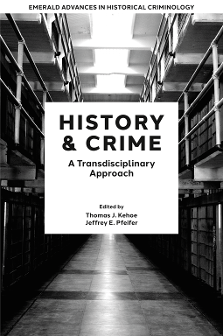
Index
ISBN: 978-1-80117-699-6, eISBN: 978-1-80117-698-9
Publication date: 15 September 2021
Citation
(2021), "Index", Kehoe, T.J. and Pfeifer, J.E. (Ed.) History & Crime (Emerald Advances in Historical Criminology), Emerald Publishing Limited, Leeds, pp. 235-242. https://doi.org/10.1108/978-1-80117-698-920211017
Publisher
:Emerald Publishing Limited
Copyright © 2021 Thomas J. Kehoe and Jeffrey E. Pfeifer. Published under an exclusive licence by Emerald Publishing Limited
INDEX
- Prelims
- Chapter 1 Making Sense of History and Crime through a Synthesised Framework
- Part I Historical Research on Crime
- Chapter 2 Killing in Secret: State and Popular Perceptions of Infanticide in Early Modern Europe
- Chapter 3 A Public Claim to Madness: Restoring Context to Forensic Psychiatry in Late Nineteenth-Century Victoria
- Chapter 4 Towards a History of Deviance: Policing Drunkenness in Mid-Nineteenth-Century New South Wales
- Chapter 5 The Dazed and Dangerous Delinquents of Sin City: Policing and Detaining Juvenile Delinquents in Twentieth-Century Las Vegas
- Chapter 6 Containing the Undesirables: Discretion and the Sentencing of Habitual Criminals in Australian Supreme Courts in the Twentieth Century
- Chapter 7 The History of Forensic Psychology in Australia through a Legal Adjudication Narrative Lens: Cases from the Court of Criminal Jurisdiction
- Part II Crime Research from a Historical Perspective
- Chapter 8 Historical Criminology as a Field for Interdisciplinary Research and Trans-disciplinary Discourse
- Chapter 9 Status Quotidian: Microhistory and the Study of Crime
- Chapter 10 Breaking Down the Blue Wall: Using Historical Criminology to Map Entrenched Networks of Police Corruption
- Chapter 11 Historical Methods in the Critical Study of Drug Policy
- Chapter 12 Making the Case for a Feminist Historical Criminology: Female Homicide Offending in Victoria 1860–1920
- Chapter 13 ‘Winning Hearts and Minds’: A Historically Motivated Model for Reactions to Occupation Strategy
- Chapter 14 History, Crime Studies and the Use of History for Impact-based Research
- Index